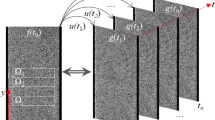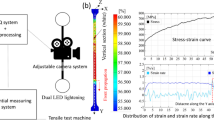Abstract
In this study, the 3D digital image correlation technique is combined with the inverse modeling methodology to determine mechanical properties of the weld line including heated-affected zone (HAZ). The literature showed that identification of detailed mechanical properties of the weld line is critical to the characterization of mechanical performance of such welded structures as tailor-welded blanks (TWBs). Typically, power law material constitutive model is adopted to simulate the elastoplastic response of the welded structures in finite element analysis, in which the two elastoplastic parameters, i.e., strain hardening exponent n and strength coefficient K, need to be determined in different weld zones, respectively. In this study, the strain hardening exponent is first determined by 3D digital image correlation (DIC) technique that has been widely used to measure strain experimentally. Then, the strength coefficient K is determined on the basis of the results obtained from the first step by using an inverse modeling technique. To validate the identified material parameters, the indentation tests are carried out in different welded zones and the load–depth curves are correlated to the corresponding modeling results, thereby demonstrating that the identification procedure of the mechanical properties is effective.
Similar content being viewed by others
References
Gery D, Long H, Maropoulos P (2005) Effects of welding speed, energy input and heat source distribution on temperature variations in butt joint welding. J Mater Process Technol 167:393–401
Liu P, Li YJ, Geng HR, Wang J (2007) Microstructure characteristics in TIG welded joint of Mg/Al dissimilar materials. Mater Lett 61:1288–1291
Xu FX, Sun GY, Li GY, Li Q (2013) Crashworthiness design of multi-component tailor-welded blank (TWB) structures. Struct Multidiscip Optim 48:653–667
Xu FX, Sun GY, Li GY, Li Q (2013) Experimental investigation on high strength steel (HSS) tailor-welded blanks (TWBs). J Mater Process Technol 214:925–935
Xu FX, Sun GY, Li GY, Li Q (2014) Experimental study on crashworthiness of tailor-welded blank (TWB) thin-walled high-strength steel (HSS) tubular structures. Thin-Walled Struct 74:12–27
Jie M, Chow CL, Cheng CH, Chan LC (2005) Forming limit analysis of aluminum tailor-welded blanks. Proc ASME Appl Mech Div 256:61–67
Davies R, Grant G, Smith M, Oliver E (2000) Formability and fatigue of aluminum tailor-welded blanks. SAE Trans J Mater Manuf 109:911–918
Raymond SD, Wild PA, Bayley CJ (2004) On modeling of the weld line in finite element analyses of tailor-welded blank forming operations. J Mater Process Technol 147:28–37
Wang LJ, Wang GD, Liu XH, Wu MT (2007) Numerical study on welding line behavior of deep drawing TWB process. J Iron Steel Res Int 14(36–38):46
Tang BT, Zhao Z, Yu S, Chen J, Ruan XY (2007) One-step FEM based control of weld line movement for tailor-welded blanks forming. J Mater Process Technol 187–188:383–386
Köklü U (2013) Investigation into the formability of Al-1050 tailor-welded blanks with antilock braking system. Int J Adv Manuf Technol 66:221–229
Abbasi M, Hamzeloo SR, Ketabchi M, Shafaat MA, Bagheri B (2014) Analytical method for prediction of weld line movement during stretch forming of tailor-welded blanks. Int J Adv Manuf Technol. doi:10.1007/s00170-014-5850-3
Tang BT, Zhao Z, Wang Y (2007) One-step FEM-based evaluation of weld line movement and development of blank in sheet metal stamping with tailor-welded blanks. Int J Adv Manuf Technol 35:268–279
Abdullah K, Wild PM, Jeswiet JJ, Ghasempoor A (2001) Tensile testing for weld deformation properties in similar gage tailor welded blanks using the rule of mixtures. J Mater Process Technol 112:91–97
Kim J, Kim YW, Kang BS, Hwang SM (2004) Finite element analysis for bursting failure prediction in bulge forming of a seamed tube. Finite Elem Anal Des 40:953–966
Cao YP, Lu J (2004) A new method to extract the plastic properties of metal materials from an instrumented spherical indentation loading curve. Acta Mater 52:4023–4032
Yonezu A, Yoneda K, Hirakata H, Sakihara M, Minoshima K (2010) A simple method to evaluate anisotropic plastic properties, based on dimensionless function of single spherical indentation,-application to SiC whisker reinforced aluminum alloy. Mater Sci Eng A 527:7646–7657
Farrissey LM, McHugh PE (2005) Determination of elastic and plastic material properties using indentation: development of method and application to a thin surface coating. Mater Sci Eng A 399:254–266
Kucharski S, Mroz Z (2007) Identification of yield stress and plastic hardening parameters from a spherical indentation test. Int J Mech Sci 49:1238–1250
Lan HZ, Venkatesh TA (2007) Determination of the elastic and plastic properties of materials through instrumented indentation with reduced sensitivity. Acta Mater 55:2025–2041
Ghosh S, Pal TK, Mukherjee S, Das G, Ghosh S (2008) Comparative study of heat-affected zone with weld and base material after post-weld heat treatment of HSLA steel using ball indentation technique. J Mater Sci 43:5474–5482
Zhan M, Du HF, Liu J, Ren N, Yang H, Jiang HM, Diao KS, Chen XP (2010) A method for establishing the plastic constitutive relationship of the weld bead and heat-affected zone of welded tubes based on the rule of mixtures and a microhardness test. Mater Sci Eng A 527:2864–2874
Ye DY, Mi F, Liou JZ, Xu YD, Chen YZ, Xiao L (2013) Use of instrumented indentation testing to study local mechanical properties of 304 L SS welded joints subjected to low-cycle fatigue loadings. Mater Sci Eng A 564:76–84
Charitidis CA, Dragatogiannis DA (2013) Finite element analysis, stress–strain distribution and size effects rise during nanoindentation of welded aluminum alloy. Int J Struct Integr 4:78–90
Chung KH, Lee W, Kim JH, Kim CM, Park SH, Kwon D, Chung K (2009) Characterization of mechanical properties by indentation tests and FE analysis—validation by application to a weld zone of DP590 steel. Int J Solids Struct 46:344–363
Iskander M (2010) Digital image correlation. Model. Transparent soils: 137–164
Hu ZX, Zhu L, Teng JX, Ma XH, Shi XJ (2009) Evaluation of three-dimensional surface roughness parameters based on digital image processing. Int J Adv Manuf Technol 40:342–348
Chu TC, Ranson WF, Sutton MA, Peters WH (1985) Applications of digital-image-correlation techniques to experimental mechanics. Exp Mech 25:232–244
Bruck HA, McNeill SR, Sutton MA, Peters WH (1989) Digital image correlation using Newton–Raphson method of partial differential correction. Exp Mech 29:261–267
Peters WH, Ranson WF (1982) Digital imaging techniques in experimental stress analysis. Opt Eng 21:427–431
Synnergren P, Sjodahl M (1999) A stereoscopic digital speckle photography system for 3-D displacement field measurements. Opt Lasers Eng 31:425–443
Sutton MA, McNeill SR, Helm DJ, Chao YJ (2000) Advances in two-dimensional and three-dimensional computer vision. Photomech 77:323–372
Sutton MA, Helm JD, Boone ML (2001) Experimental study of crack growth in thin sheet material under tension-torsion loading. Int J Fract 109:285–301
Sutton MA, Orteu JJ, Schreier HW (2009) Image correlation for shape, motion and deformation measurements: basic concepts, theory and applications. Springer Verlag, New York
Tong W, Tao H, Zhang N, Jiang XQ, Marya MP, Hector LG, Gayden XQ (2005) Deformation and fracture of miniature tensile bars with resistance-spot-weld microstructures. Metall Mater Trans A 36:2651–2669
Brauser S, Pepke LA, Weber G, Rethmeier M (2010) Deformation behaviour of spot-welded high strength steels for automotive applications. Mater Sci Eng A 527:7099–7108
Savic V, Hector LG, Fekete JR (2010) Digital image correlation study of plastic deformation and fracture in fully martensitic steels. Exp Mech 50:99–110
Sorgente D, Palumbo G, Scintilla LD, Tricarico L (2013) Evaluation of the strain behaviour of butt joints on AZ31 magnesium alloy thin sheets welded by Nd: YAG laser. Int J Adv Manuf Technol 67:2753–2763
Giachetti A (2000) Matching techniques to compute image motion. Image Vision Comput 18:247–260
Tarigopula V, Hopperstad OS, Langseth M, Clausen AH, Hild F (2008) A study of localisation in dual-phase high-strength steels under dynamic loading using digital image correlation and FE analysis. Int J Solids Struct 45:601–619
Hung PC, Voloshin AS (2003) In-plane strain measurement by digital image correlation. J Braz Soc Mech Sci Eng 25:215–221
Lu H, Cary PD (2000) Deformation measurements by digital image correlation: implementation of a second-order displacement gradient. Exp Mech 40:393–400
Wattrisse B, Chrysochoos A, Muracciole JM, Némoz-Gaillard M (2001) Analysis of strain localization during tensile tests by digital image correlation. Exp Mech 41:29–39
Sutton MA, Wolters WJ, Peters WH, Ranson WF, McNeill SR (1983) Determination of displacements using an improved digital correlation method. Image Vision Comput 1:133–139
Sutton MA, Cheng MQ, Peters WH, Chao YJ, McNeill SR (1986) Application of an optimized digital correlation method to planar deformation analysis. Image Vision Comput 4:143–150
Hild F, Roux S (2006) Digital image correlation: from displacement measurement to identification of elastic properties—a review. Strain 42:69–80
Verhulp E, van Rietbergen B, Huiskes R (2004) A three-dimensional digital image correlation technique for strain measurements in microstructures. J Biomech 37:1313–1320
Farabi N, Chen DL, Zhou Y (2011) Microstructure and mechanical properties of laser welded dissimilar DP600/DP980 dual-phase steel joints. J Alloys Compd 509:982–989
Farabi N, Chen DL, Li J, Zhou Y, Dong SJ (2010) Microstructure and mechanical properties of laser welded DP600 steel joints. Mater Sci Eng A 527:1215–1222
Xia MS, Biro E, Tian ZL, Norman Zhou Y (2008) Effects of heat input and martensite on HAZ softening in laser welding of dual phase steels. ISIJ Int 48:809–814
Xia MS, Kuntz ML, Tian ZL, Zhou Y (2008) Failure study on laser welds of dual phase steel in formability testing. Sci Technol Weld Join 13:378–387
Cheng CH, Jie M, Chan LC, Chow CL (2007) True stress–strain analysis on weldment of heterogeneous tailor-welded blanks—a novel approach for forming simulation. Int J Mech Sci 49:217–229
Nielsen KL (2008) 3D modelling of plug failure in resistance spot welded shear-lab specimens (DP600-steel). Int J Fract 153:125–139
Marya M, Gayden XQ (2005) Development of requirements for resistance spot welding dual-phase (DP600) steels part 2: statistical analyses and process maps. Weld J 84:197–204
Marya M, Gayden XQ (2005) Development of requirements for resistance spot welding dual-phase (DP600) steels. Part 1—the causes of interfacial fracture. Weld J 84:172–182
Long X, Khanna SK (2007) Fatigue properties and failure characterization of spot welded high strength steel sheet. Int J Fatigue 29:879–886
Sun GY, Xu FX, Li GY, Huang XD, Li Q (2014) Determination of mechanical properties of the weld line by combining micro-indentation with inverse modeling. Comput Mater Sci 85:347–362
Roque AP, Natal Jorge RM, Parente MPL, Fontes Valente RA, Fernandes AA (2005) Influence of the heat affected zone on hydroforming with tailor-welded tubular blanks. The 8th International Conference on Computational Plasticity
Author information
Authors and Affiliations
Corresponding author
Rights and permissions
About this article
Cite this article
Li, G., Xu, F., Sun, G. et al. Identification of mechanical properties of the weld line by combining 3D digital image correlation with inverse modeling procedure. Int J Adv Manuf Technol 74, 893–905 (2014). https://doi.org/10.1007/s00170-014-6034-x
Received:
Accepted:
Published:
Issue Date:
DOI: https://doi.org/10.1007/s00170-014-6034-x




